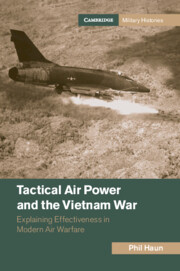Refine search
Actions for selected content:
15401 results in Military history
Copyright page
-
- Book:
- Purpose and Power
- Published online:
- 11 January 2024
- Print publication:
- 11 January 2024, pp iv-iv
-
- Chapter
- Export citation
Maps
-
- Book:
- Purpose and Power
- Published online:
- 11 January 2024
- Print publication:
- 11 January 2024, pp x-x
-
- Chapter
- Export citation
14 - For Want of a Vision: The Carter Years, 1977–1981
- from Part II - From Great Power to Superpower
-
- Book:
- Purpose and Power
- Published online:
- 11 January 2024
- Print publication:
- 11 January 2024, pp 477-496
-
- Chapter
- Export citation
Dedication
-
- Book:
- Purpose and Power
- Published online:
- 11 January 2024
- Print publication:
- 11 January 2024, pp v-vi
-
- Chapter
- Export citation
19 - Retrenchment, Engagement, and War: The Obama Years, 2009–2017
- from Part IV - Retreat and Defeat
-
- Book:
- Purpose and Power
- Published online:
- 11 January 2024
- Print publication:
- 11 January 2024, pp 633-660
-
- Chapter
- Export citation
20 - Retrenchment, Engagement, and Weakness: Trump and Biden, 2017–2022
- from Part IV - Retreat and Defeat
-
- Book:
- Purpose and Power
- Published online:
- 11 January 2024
- Print publication:
- 11 January 2024, pp 661-695
-
- Chapter
- Export citation
Contents
-
- Book:
- Purpose and Power
- Published online:
- 11 January 2024
- Print publication:
- 11 January 2024, pp vii-viii
-
- Chapter
- Export citation
3 - Seeking a Continent: Expansion, Indian Removal, and the Mexican War, 1817–1849
- from Part I - From Backwater to Great Power
-
- Book:
- Purpose and Power
- Published online:
- 11 January 2024
- Print publication:
- 11 January 2024, pp 77-117
-
- Chapter
- Export citation
Part II - From Great Power to Superpower
-
- Book:
- Purpose and Power
- Published online:
- 11 January 2024
- Print publication:
- 11 January 2024, pp 225-534
-
- Chapter
- Export citation
16 - The Gulf War, or First Iraq War, 1990–1991
- from Part III - The Post–Cold War World
-
- Book:
- Purpose and Power
- Published online:
- 11 January 2024
- Print publication:
- 11 January 2024, pp 537-559
-
- Chapter
- Export citation
17 - The New World Disorder: Bush and Clinton, 1991–2001
- from Part III - The Post–Cold War World
-
- Book:
- Purpose and Power
- Published online:
- 11 January 2024
- Print publication:
- 11 January 2024, pp 560-588
-
- Chapter
- Export citation
9 - Moving Astride the World: The Second World War, 1939–1945
- from Part II - From Great Power to Superpower
-
- Book:
- Purpose and Power
- Published online:
- 11 January 2024
- Print publication:
- 11 January 2024, pp 294-343
-
- Chapter
- Export citation
4 - Schism, Civil War, and Reconstruction, 1849–1877
- from Part I - From Backwater to Great Power
-
- Book:
- Purpose and Power
- Published online:
- 11 January 2024
- Print publication:
- 11 January 2024, pp 118-155
-
- Chapter
- Export citation
Part IV - Retreat and Defeat
-
- Book:
- Purpose and Power
- Published online:
- 11 January 2024
- Print publication:
- 11 January 2024, pp 631-703
-
- Chapter
- Export citation
Notes
-
- Book:
- Purpose and Power
- Published online:
- 11 January 2024
- Print publication:
- 11 January 2024, pp 705-823
-
- Chapter
- Export citation
Index
-
- Book:
- Purpose and Power
- Published online:
- 11 January 2024
- Print publication:
- 11 January 2024, pp 824-859
-
- Chapter
- Export citation

Resistance and Liberation
- France at War, 1942-1945
-
- Published online:
- 05 January 2024
- Print publication:
- 25 January 2024

Tactical Air Power and the Vietnam War
- Explaining Effectiveness in Modern Air Warfare
-
- Published online:
- 04 January 2024
- Print publication:
- 18 January 2024

The Cambridge Companion to Alexander the Great
-
- Published online:
- 04 January 2024
- Print publication:
- 18 January 2024
Chapter 5 - Remembering Sparta’s Other Liberators
-
- Book:
- Sparta and the Commemoration of War
- Published online:
- 08 December 2023
- Print publication:
- 21 December 2023, pp 142-170
-
- Chapter
- Export citation
